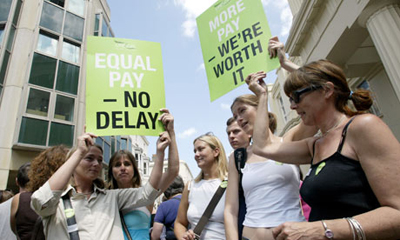 Professor Simon Deakin led a research project with Sarah Braser Butlin (University of Cambridge), Colm McLaughlin (University College Dublin) and Aleksandra Polanska (University of Cambridge) which undertook a socio-legal case study of the recent equal pay litigation wave in Britain.
Professor Simon Deakin led a research project with Sarah Braser Butlin (University of Cambridge), Colm McLaughlin (University College Dublin) and Aleksandra Polanska (University of Cambridge) which undertook a socio-legal case study of the recent equal pay litigation wave in Britain.
The research finds that the increase in the number of equal pay claims during the 2000s, triggered by the entry of no-win, no-fee law firms into this part of the legal services market, helped win equal pay for "unprecedented" numbers of women.
Before 1970, discrimination formally based on gender was not unusual, with different pay grades applying to women and men. At that time, average hourly wages for women were only about 60 per cent of the male average. Following the adoption of the Equal Pay Act in 1970, this type of direct discrimination was phased out, largely through collective bargaining between unions and employers. However, indirect discrimination, associated with occupational segregation, remained a major problem.
In the mid-2000s, the number of equal pay claims rose from about 8,000 a year in 2004-05, to a peak of more than 60,000 cases in 2007-08. This change was catalysed by the entry of no-win, no-fee law firms, which targeted local authorities that had been slow to implement the principle of 'single status' across different occupational grades. In some cases, law firms organised claims against unions which were accused of favouring male workers over female ones when negotiating local agreements.
Subsequently, the unions themselves played an active role in supporting equal pay claims. Almost all the large-scale lawsuits in this period involved staff employed by local government and public health services, partly as collective bargaining agreements made it easier to tell where women were being underpaid. Unison and the GMB unions together brought some 70,000 equal pay cases between 2004 and 2008.
The paper concludes that litigation may be a more potent agent for social change than had been appreciated by some other recent analyses which had downplayed the role of the law.
The paper was published in the March edition of the Cambridge Journal of Economics which was a special issue entitled 'Special Issue: Equal Pay as a Moving Target: International perspectives on forty-years of addressing the gender pay gap', and is also available via the Cambridge Research Paper Series on SSRN.
This research also featured in an article in The Independent featuring interviews with Solicitors practicing in the field.
Photograph: Frank Baron/Guardian

 Facebook
Facebook  X/Twitter
X/Twitter  Instagram
Instagram  YouTube
YouTube  Flickr
Flickr  LinkedIn
LinkedIn